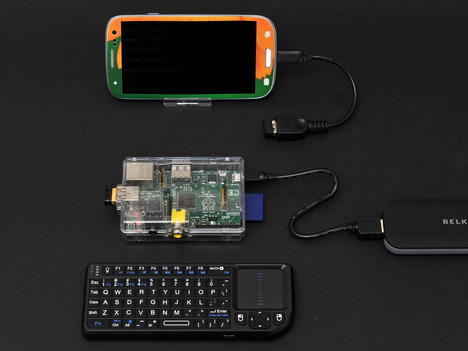Build a Portable Android-based Raspberry Pi Station

Productivity Sauce
Transforming a bare-bones Raspberry Pi into a fully-functional portable station is a popular pastime among enterprising users, and you can easily find instructions on how to build a Kindleberry Pi, a Kindleberry Wireless, and even a Raspberry Pi Linux laptop. But if you happen to use an Android device, you can opt for a less complicated and more modular solution devised by yours truly.
The Android device in this setup acts both as a wireless hotspot and a display for Raspberry Pi. The latter is configured to automatically connect to the Wi-Fi network created by the Android device. And an SSH client app (e.g., VX ConnectBot) running on the Android device is used to access Raspberry Pi via an SSH connection. Here is what you need for this project:
- Android device with wireless hotspot functionality
- An SSH client app like VX ConnectBox installed on the Android device
- OTG (On-The-Go) micro-USB cable (not required for use with a Bluetooth keyboard)
- Wireless mini keyboard with integrated touchpad like the one from Rii
- Wi-Fi USB dongle known to work with Raspberry Pi (e.g., Edimax EW-7811Un)
- Optional external battery pack for powering Raspbery Pi
Start with connecting the keyboard to the Android device using the OTG micro-USB cable. Alternatively, you can use a Bluetooth keyboard which eliminates the need for the cable and makes the entire setup even more elegant. Enable then the wireless hotspot feature. Configure Raspberry Pi to automatically connect to the wireless hotspot. You can do this using the graphical network configuration utility supplied with the Raspbian Linux distribution, or by editing network configuration files by hand. Once you've done that, Raspberry Pi should automatically connect to the wireless hotspot on every boot. On the Android device, find out Raspberry Pi's IP address, then use the SSH client app to establish an SSH connection to it. That's all there is to it. It's also possible to install a VNC server on Raspberry Pi and access its graphical desktop environment using a VNC client on the Android device.
comments powered by DisqusSubscribe to our Linux Newsletters
Find Linux and Open Source Jobs
Subscribe to our ADMIN Newsletters
Support Our Work
Linux Magazine content is made possible with support from readers like you. Please consider contributing when you’ve found an article to be beneficial.

News
-
Debian 13.0 Officially Released
After two years of development, the latest iteration of Debian is now available with plenty of under-the-hood improvements.
-
Upcoming Changes for MXLinux
MXLinux 25 has plenty in store to please all types of users.
-
A New Linux AI Assistant in Town
Newelle, a Linux AI assistant, works with different LLMs and includes document parsing and profiles.
-
Linux Kernel 6.16 Released with Minor Fixes
The latest Linux kernel doesn't really include any big-ticket features, just a lot of lines of code.
-
EU Sovereign Tech Fund Gains Traction
OpenForum Europe recently released a report regarding a sovereign tech fund with backing from several significant entities.
-
FreeBSD Promises a Full Desktop Installer
FreeBSD has lacked an option to include a full desktop environment during installation.
-
Linux Hits an Important Milestone
If you pay attention to the news in the Linux-sphere, you've probably heard that the open source operating system recently crashed through a ceiling no one thought possible.
-
Plasma Bigscreen Returns
A developer discovered that the Plasma Bigscreen feature had been sitting untouched, so he decided to do something about it.
-
CachyOS Now Lets Users Choose Their Shell
Imagine getting the opportunity to select which shell you want during the installation of your favorite Linux distribution. That's now a thing.
-
Wayland 1.24 Released with Fixes and New Features
Wayland continues to move forward, while X11 slowly vanishes into the shadows, and the latest release includes plenty of improvements.

